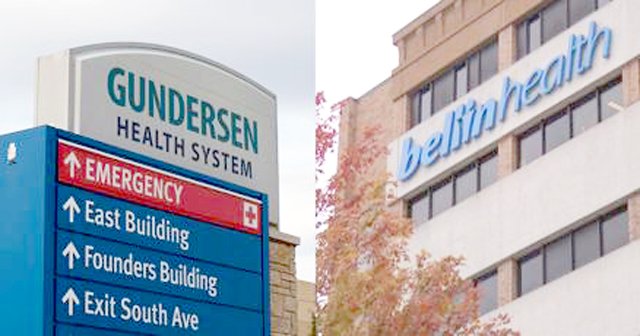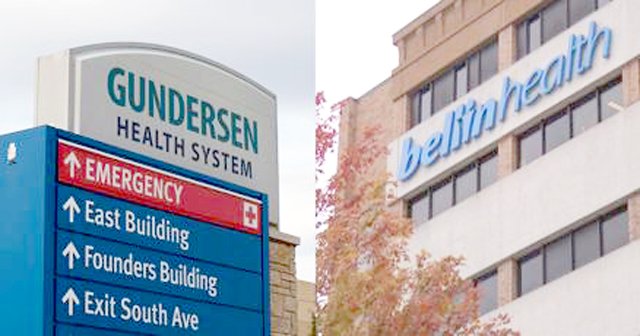UPPER MIDWEST - Leaders at Gundersen Health Systems and Bellin Health announced last week that they intend to merge. The consolidation would create a vast network of hospitals and clinics stretching from Michigan’s Upper Peninsula to northeastern Iowa.
No closures or layoffs are planned, both leaders stressed. “We don’t see that this is a decrease in workforce in any way, shape, or form,” said Gundersen CEO Scott Rathgaber at a press conference last week. “As we grow, we'll actually have more of those jobs, not less.”
Gundersen patients in the Boscobel area will see little change, according to Theresa Braudt, the administrator of the Boscobel Hospital and its clinics.
“It’s not going to change their care,” said Braudt. “We are going to continue to focus on improving the health of our community.”
Braudt hailed the merger as promising for both sides. “The opportunity to have a partner that shares our mission is great,” she said.
The merger would create a network of 11 hospitals and more than 100 clinics with more than 14,000 employees. Gundersen and Bellin currently rank 12th and 28th respectively for patient volume among Wisconsin hospitals, according to data compiled by Dexur healthcare rankings and research. After the merger, the new entity would rank 6th, by the same metric.
Any merger must be reviewed and approved by anti-trust and other regulatory agencies at the state and federal level.
Sharing resources
Leaders of both organizations described the merger as a partnership among equals: Two non-profit healthcare networks with a shared mission of affordable access to rural healthcare. Thus, the primary purpose of the merger, according to the leaders, is to combine resources in order increase their reach, especially to rural patients.
“One of the things that we learned during the pandemic was that technology can really serve us well,” explained Chris Woleski, CEO of Bellin. “We can reach more patients using technology, by virtual visits, and video visits, etc. And it's expensive technology. But together, if we pool our resources and invest in that technology, just think of what we could do in reaching people who otherwise haven't had great access to health care.”
The two organizations will retain their respective names and headquarters in Green Bay and La Crosse. New oversight would be provided by a systemwide CEO (slated to be Rathgaber) and a board of directors, which will be chaired by John Dykema, currently Chair of Bellin’s board. Chris Woleske would serve as System Executive Vice President and Regional President of Wisconsin’s northern counties.
Merger pitfalls
Healthcare mergers have grown increasingly common, although the pace of consolidation slowed during the pandemic. A growing body of research demonstrates that such mergers tend to drive up the cost of insurance premiums and depress wage growth at hospitals and clinics, with little measurable improvement in patient care.
“There’s a pretty natural explanation for that, which is that the merged, single entity becomes more of a monopoly,” explained Justin Sydnor, a professor of risk and insurance at UW Madison. Without any competitive pressure, costs tend to drift upward, while wages slow their growth rate as employees lose the opportunity to shop around for jobs.
This phenomenon is more likely to occur in a metropolitan area where, for example, a hospital merger creates a monopoly, according to Sydnor. It can, however, take place over geographically diverse markets.
“That happens when the new, merged health system has greater leverage with insurers who are trying to operate a network across the state, for instance employers with employees scattered across the state,” said Sydnor.
Price increases
In an interview with the Dial, Rathgaber raised several factors that make this merger different.
For one thing, the new entity will continue to compete with other hospitals in both service areas. For another, he cites the long history cost containment at both Gundersen and Bellin.
“We have a mission to bring cost savings to the patients,” Rathgaber said. “We’ve been doing that here in Gundersen for a number of years. Bellin has done the same thing. If you add up the cumulative price increases, they’ve been among the lowest in the state.”
A spot-check of Medicare and Medicaid data for some common treatments such as heart failure, hip replacement, and pneumonia bears out this claim. Gundersen’s charges and Medicare markups are not only lower than the national average, but also than its competitor in La Crosse, the Mayo hospital.
Another key element in cost containment is health insurance, Rathgaber said. Unlike most hospitals, Gundersen is part owner of a healthcare insurance plan, Quartz, and about a third of its patients use the plan.
“That gives us a mechanism to bring that savings directly to our patients. We have much more control over it, and no shareholders to answer to,” he said. Bellin is also part owner of an insurance firm, Robin Healthcare.
Ultimately, Rathgaber said that the non-profit missions of the two healthcare systems will prevail over market pressures to capitalize on the expanded reach of the merged system.
“We have no intention of cornering the market and increasing fees,” he said. “If we did that, you would be right in holding us accountable. We plan to use this as a platform to control costs and get that savings back to our communities,” he said.



